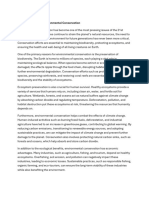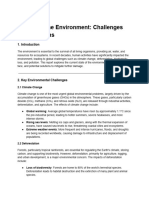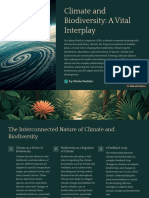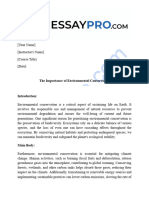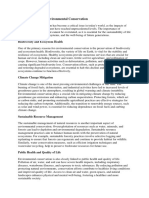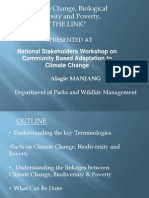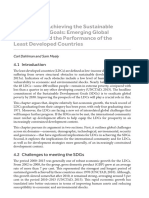0 ratings0% found this document useful (0 votes)
Climate Change and Biodiversity
Climate Change and Biodiversity
Uploaded by
montayremerlynSummary of Climate change and Biodiversity
Copyright:
© All Rights Reserved
Available Formats
Download as DOCX, PDF, TXT or read online from Scribd
Download as docx, pdf, or txt
Climate Change and Biodiversity
Climate Change and Biodiversity
Uploaded by
montayremerlyn0 ratings0% found this document useful (0 votes)
Summary of Climate change and Biodiversity
Copyright
© © All Rights Reserved
Available Formats
DOCX, PDF, TXT or read online from Scribd
Share this document
Did you find this document useful?
Is this content inappropriate?
Summary of Climate change and Biodiversity
Copyright:
© All Rights Reserved
Available Formats
Download as DOCX, PDF, TXT or read online from Scribd
Download as docx, pdf, or txt
0 ratings0% found this document useful (0 votes)
Climate Change and Biodiversity
Climate Change and Biodiversity
Uploaded by
montayremerlynSummary of Climate change and Biodiversity
Copyright:
© All Rights Reserved
Available Formats
Download as DOCX, PDF, TXT or read online from Scribd
Download as docx, pdf, or txt
You are on page 1/ 6
BIODIVERSITY AND CLIMATE CHANGE
Climate Change:
• A significant threat to our planet.
• Caused by greenhouse gas emissions.
• Leads to rising temperatures, extreme weather events, and rising sea
levels.
Biodiversity:
• The variety of life on Earth.
• Essential for ecosystem health and human well-being.
• Threatened by human activities, including climate change.
Impact of Climate Change on Biodiversity:
• Habitat Loss and Fragmentation: Destruction of natural habitats due to
rising sea levels, extreme weather events, and land-use changes.
• Altered Phenology: Disruption of biological cycles like migration, breeding,
and flowering.
• Range Shifts: Species moving to more suitable climates, leading to
potential conflicts and competition.
• Increased Stress and Mortality: Extreme weather events and changing
environmental conditions can directly harm organisms.
• Ocean Acidification: Increased CO2 absorption in oceans, harming marine
life.
• Spread of Invasive Species: Climate change can create favorable conditions
for invasive species.
Addressing Climate Change and Protecting Biodiversity:
• Reducing Greenhouse Gas Emissions: Transitioning to renewable energy,
improving energy efficiency, and reducing fossil fuel use.
• Protecting and Restoring Ecosystems: Conserving forests, wetlands, and
other natural habitats.
• Sustainable Land Use Practices: Adopting sustainable agriculture and
forestry practices.
• International Cooperation: The Paris Agreement aims to limit global
warming to below 2°C, but additional efforts are needed to combat climate
change.
• Community-Based Conservation: Involving local communities in
conservation efforts.
Role of Biodiversity in Mitigating Climate Change
• By aiding in carbon sequestration and climate stabilization, biodiversity is
essential in preventing climate change.
• For controlling the Earth's atmosphere, forests, wetlands, and oceans are
among the largest carbon sinks on the world.
• The health of these ecosystems and the benefits they render depend on
biodiversity.
• Mangrove forests, can shield coastal settlements from storm surges and
sea level rise.
• Coral reefs can protect coastlines from erosion and absorb the energy of
waves.
• Ecosystems rich in biodiversity are more resilient to climate change, as
they have more capacity to adapt to changing conditions.
• Therefore, protecting biodiversity is essential for mitigating climate change
impacts and promoting long- term sustainability.
• Morecroft et al. (2019) illustrated the importance of biodiversity,
ecosystem, and humans in mitigating climate change:
• Reforestation
• Forest creation in unsuitable areas
• River Restoration
• Wetland Restoration
• Protection and expansion of natural/seminatural areas
• Increased Connectivity
• Species Translocation
• Natural fire regime restoration
Impact of Human Activities on Biodiversity and Climate Change
• Climate change and biodiversity have both been significantly impacted by
human activity.
• Through destroying habitats and ecosystems, agriculture, urbanization, and
deforestation have all habitats contributed to loss of biodiversity.
• Human actions have also contributed to climate change, particularly the
greenhouse gas emissions from the burning of fossil fuels and other
industrial operations.
• This gas emission has led to changes in temperature, weather patterns,
sea levels, and ocean acidity, which have affected biodiversity and
ecosystems.
• human activities have caused the extinction of many plant and animal
species, leading to reduced biodiversity.
• It is vital to address these effects through conservation initiatives that
strive to restore and safeguard ecosystems and biodiversity.
• Governments, corporations, and individuals must all work together to
support sustainable development, which strikes a balance between social
welfare, environmental protection, and economic progress.
CONSERVATION OF BIODIVERSITY AND ITS IMPORTANCE OF CLIMATE
CHANGE MITIGATION
Conservation of biodiversity plays a crucial role in mitigating climate
change.
(Srivastava et al., 2019). Biodiverse ecosystems provide essential
services that regulate climate, such as carbon storage, water filtration,
and nutrient cycling.
For example, forests are one of the most effective ways of
sequestering carbon, with an estimated 30% of the world's carbon
stored in forests.
By conserving forests, we can reduce carbon emissions and mitigate
climate change.
Similarly, wetlands and coral reefs also act as important carbon sinks,
and their conservation is vital to maintain the balance of the Earth's
carbon cycle.
Conserving biodiversity also helps to keep the resilience of
ecosystems, enabling them to adapt better to the impacts of climate
change, such as droughts, floods, and storms.
The Department of Environment and Natural Resources' Biodiversity
Management Bureau and other organizations with a focus on climate
change are aware of how crucial biodiversity preservation is for
mitigating climate change.
(DENR-BMB, 2016). It has highlighted a number of actions that can be
implemented, such as protected area networks, habitat restoration,
and sustainable land use practices, to preserve biodiversity.
Additionally, REDD+ projects (Reducing Emissions from Deforestation
and Forest Degradation) seek to reduce emissions by protecting forests
and increasing their capacity to store carbon.
(DENR-Forest Management Bureau, 2017). Spending money on
conservation projects helps prevent climate change and protect
biodiversity's myriad advantages, including its use in food, medicine,
and recreation.
ECOSYSTEM SERVICES AND THEIR IMPORTANCE FOR BIODIVERSITY
CONSERVATION AND CLIMATE CHANGE MITIGATION
Ecosystem services refer to humans' benefits from natural ecosystems
Four branches of ecosystem services
For ecosystems to remain stable, resilient, and able to deliver
important functions, biodiversity conservation is crucial (Oliver et al.,
2015)
For instance, forests serve biodiversity, sinks, absorbing carbon dioxide
to help reduce the consequences of climate change.
Communities can be shielded from the effects of natural disasters like
floods and storm surges by preserving and restoring coastal
ecosystems like mangroves and salt marshes.
However, human activities such as deforestation, urbanization, and
overfishing have significantly impacted the provision of ecosystem
services (Lee & Miller-Rushing, 2014).
Habitat loss and degradation have led to a decline in biodiversity,
reducing the ability of ecosystems to provide essential services and
ability to deliver essential services. For instance, the ability of coral
reefs to provide shelter as coasts from storm surges and provide
habitat for marine species is declining as a result of climate change
and human activity.
Thus, it is crucial to preserve biodiversity and safeguard ecosystems to
ensure that they can continue to provide crucial services and aid in the
mitigation of climate change.
Role of Sustainable Development in Promoting Diversity
Conservation and Climate Change
BIODIVERSITY AND SUSTAINABLE DEVELOPMENT
Biodiversity is crucial for achieving Sustainable Development
Promotes ecological balance and sustains ecosystem for future
generations
Sustainable Development is about finding a balance between growing
our economy, protecting the environment, and helping the society
thrive.
Goal of Sustainable Development
-is to promote balance between these three facets of development by
incorporating economic, social and environmental factors into decision-
making.
Sustainable Development manages ecosystem to preserve their
ecological integrity while meeting human community demands.
Requires a comprehensive strategy to manage natural resources,
acknowledging the interdependence of ecosystems and human
societies.
By increasing renewable energy sources, enhancing energy efficiency,
and lowering greenhouse gas emissions, sustainable development also
help to mitigate climate change.
Climate Change Mitigation
Strategies for Sustainable Development
-use of renewable energy sources like wind, solar and hydropower
Methods for Sustainable Development
-use of more efficient technologies in buildings and transportation
In addition, promoting the presentation of forest and other ecosystems
that remove carbon dioxide from atmosphere.
Overall:
Sustainable Development
-It helps lessen the effects of climate change
-Plays a vital role in supporting biodiversity conservation
-Maintains the long-term sustainability of the planet
-Essential for balancing ecological preservation and climate action
You might also like
- The Urgency of Environmental Conservation - Preserving Our Planet For Future GenerationsNo ratings yetThe Urgency of Environmental Conservation - Preserving Our Planet For Future Generations2 pages
- The Importance of Environmental ConservationNo ratings yetThe Importance of Environmental Conservation2 pages
- The Impact of Climate Change On BiodiversityNo ratings yetThe Impact of Climate Change On Biodiversity2 pages
- The Impact of Climate Change on Global BiodiversityNo ratings yetThe Impact of Climate Change on Global Biodiversity3 pages
- Importance of Protecting The EnvironmentNo ratings yetImportance of Protecting The Environment2 pages
- The Impact of Climate Change On Biodiversity 3No ratings yetThe Impact of Climate Change On Biodiversity 34 pages
- Climate and Biodiversity A Vital InterplayNo ratings yetClimate and Biodiversity A Vital Interplay10 pages
- The Impact of Human Activity on Global Environmental ChangeNo ratings yetThe Impact of Human Activity on Global Environmental Change3 pages
- The Importance of Environmental ConservationNo ratings yetThe Importance of Environmental Conservation1 page
- The Importance of Biodiversity For Ecosystem HealthNo ratings yetThe Importance of Biodiversity For Ecosystem Health2 pages
- The Impact of Climate Change On Biodiversity 2No ratings yetThe Impact of Climate Change On Biodiversity 23 pages
- The Importance of Environmental ConservationNo ratings yetThe Importance of Environmental Conservation2 pages
- The Impact of Climate Change On Global EcosystemsNo ratings yetThe Impact of Climate Change On Global Ecosystems1 page
- The Importance of Environmental ConservationNo ratings yetThe Importance of Environmental Conservation2 pages
- The Devastating Effects of Deforestation - An Analysis of The Environmental, Social, and Economic ConsequencesNo ratings yetThe Devastating Effects of Deforestation - An Analysis of The Environmental, Social, and Economic Consequences4 pages
- The Importance of Environmental ConservationNo ratings yetThe Importance of Environmental Conservation2 pages
- A Call To Action - Environmental and Climate Change EssayNo ratings yetA Call To Action - Environmental and Climate Change Essay2 pages
- The Importance of Biodiversity ConservationNo ratings yetThe Importance of Biodiversity Conservation2 pages
- The Impact of Climate Change On Global BiodiversityNo ratings yetThe Impact of Climate Change On Global Biodiversity1 page
- The Importance of Environmental ConservationNo ratings yetThe Importance of Environmental Conservation1 page
- Green Modern Environment and Ecology PresentationNo ratings yetGreen Modern Environment and Ecology Presentation15 pages
- The Impact of Climate Change On Biodiversity and EcosystemsNo ratings yetThe Impact of Climate Change On Biodiversity and Ecosystems2 pages
- Core Energy: The Cry of the Earth: Climate Change and the Loss of BiodiversityFrom EverandCore Energy: The Cry of the Earth: Climate Change and the Loss of BiodiversityNo ratings yet
- The Importance of Environmental ConservationNo ratings yetThe Importance of Environmental Conservation1 page
- Power Up CA Test 07 (CA2257) QP @ThelionsdenofficialNo ratings yetPower Up CA Test 07 (CA2257) QP @Thelionsdenofficial15 pages
- 01. G10-English -FinalModel-Al.Adwaa-T1-2025No ratings yet01. G10-English -FinalModel-Al.Adwaa-T1-202531 pages
- CBSE-XII English Core Chap-V3 (Journey to the End of the Earth)No ratings yetCBSE-XII English Core Chap-V3 (Journey to the End of the Earth)8 pages
- Download full The Survival Nexus: Science, Technology, and World Affairs Charles Weiss ebook all chapters100% (1)Download full The Survival Nexus: Science, Technology, and World Affairs Charles Weiss ebook all chapters41 pages
- 60 Passage 1 - The Green Revolution in China Q1-13No ratings yet60 Passage 1 - The Green Revolution in China Q1-135 pages
- Environmental Studies Assignment-1: Submitted By-Anchit Dayal, Sec-B BBA+MBA (IB) - DualNo ratings yetEnvironmental Studies Assignment-1: Submitted By-Anchit Dayal, Sec-B BBA+MBA (IB) - Dual6 pages
- Environmental Impact Assessment For Oil and Gas Projects - A CompaNo ratings yetEnvironmental Impact Assessment For Oil and Gas Projects - A Compa171 pages
- Chapter 5-Adverb Clauses of Time and Review of Verb TensesNo ratings yetChapter 5-Adverb Clauses of Time and Review of Verb Tenses7 pages
- FALKENMARK 2008 Water and SustainabilityNo ratings yetFALKENMARK 2008 Water and Sustainability14 pages
- P-POME-ACM-2202-10 PT Mitra Agrinusa Sentosa-2No ratings yetP-POME-ACM-2202-10 PT Mitra Agrinusa Sentosa-22 pages
- IELTS Reading Practice Test 5 PrintableNo ratings yetIELTS Reading Practice Test 5 Printable11 pages
- Don Mariano Marcos Memorial State University Mid La Union Campus City of San Fernando 2500 La UnionNo ratings yetDon Mariano Marcos Memorial State University Mid La Union Campus City of San Fernando 2500 La Union10 pages
- The Urgency of Environmental Conservation - Preserving Our Planet For Future GenerationsThe Urgency of Environmental Conservation - Preserving Our Planet For Future Generations
- The Impact of Climate Change on Global BiodiversityThe Impact of Climate Change on Global Biodiversity
- The Impact of Human Activity on Global Environmental ChangeThe Impact of Human Activity on Global Environmental Change
- The Importance of Biodiversity For Ecosystem HealthThe Importance of Biodiversity For Ecosystem Health
- The Devastating Effects of Deforestation - An Analysis of The Environmental, Social, and Economic ConsequencesThe Devastating Effects of Deforestation - An Analysis of The Environmental, Social, and Economic Consequences
- A Call To Action - Environmental and Climate Change EssayA Call To Action - Environmental and Climate Change Essay
- The Impact of Climate Change On Global BiodiversityThe Impact of Climate Change On Global Biodiversity
- The Impact of Climate Change On Biodiversity and EcosystemsThe Impact of Climate Change On Biodiversity and Ecosystems
- Core Energy: The Cry of the Earth: Climate Change and the Loss of BiodiversityFrom EverandCore Energy: The Cry of the Earth: Climate Change and the Loss of Biodiversity
- Power Up CA Test 07 (CA2257) QP @ThelionsdenofficialPower Up CA Test 07 (CA2257) QP @Thelionsdenofficial
- CBSE-XII English Core Chap-V3 (Journey to the End of the Earth)CBSE-XII English Core Chap-V3 (Journey to the End of the Earth)
- Download full The Survival Nexus: Science, Technology, and World Affairs Charles Weiss ebook all chaptersDownload full The Survival Nexus: Science, Technology, and World Affairs Charles Weiss ebook all chapters
- 60 Passage 1 - The Green Revolution in China Q1-1360 Passage 1 - The Green Revolution in China Q1-13
- Environmental Studies Assignment-1: Submitted By-Anchit Dayal, Sec-B BBA+MBA (IB) - DualEnvironmental Studies Assignment-1: Submitted By-Anchit Dayal, Sec-B BBA+MBA (IB) - Dual
- Environmental Impact Assessment For Oil and Gas Projects - A CompaEnvironmental Impact Assessment For Oil and Gas Projects - A Compa
- Chapter 5-Adverb Clauses of Time and Review of Verb TensesChapter 5-Adverb Clauses of Time and Review of Verb Tenses
- Don Mariano Marcos Memorial State University Mid La Union Campus City of San Fernando 2500 La UnionDon Mariano Marcos Memorial State University Mid La Union Campus City of San Fernando 2500 La Union








